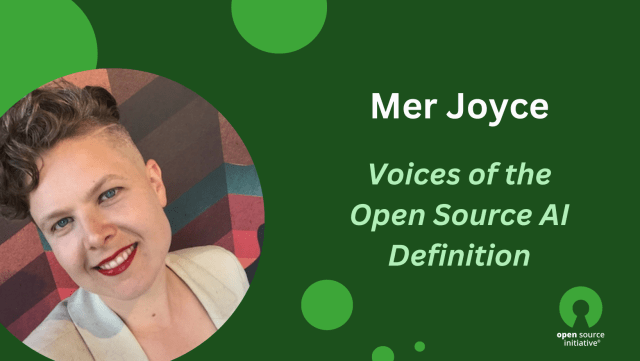Mer Joyce: voices of the Open Source AI Definition
The Open Source Initiative (OSI) is running a series of stories about a few of the people involved in the Open Source AI Definition (OSAID) co-design process. We’ll be featuring the voices of the volunteers who have helped shape and are shaping the Definition.
The OSI started researching the topic in 2022, and in 2023 began the co-design process of a new definition of Open Source that applies to AI. The OSI hired Mer Joyce, founder and principal of Do Big Good, as an independent consultant to lead the co-design process. She has worked for over a decade at the intersection of research, policy, innovation and social change.

About co-design
Co-design, also called participatory or human-centered design, is a set of creative methods used to solve communal problems by sharing knowledge and power. The co-design methodology addresses the challenges of reaching an agreed definition within a diverse community (Costanza-Chock, 2020: Escobar, 2018: Creative Reaction Lab, 2018: Friedman et al., 2019).
As noted in MIT Technology Review’s article about the OSAID, “[t]he open-source community is a big tent… encompassing everything from hacktivists to Fortune 500 companies…. With so many competing interests to consider, finding a solution that satisfies everyone while ensuring that the biggest companies play along is no easy task.” (Gent, 2024).
The co-design method allows for the integration of diverging perspectives into one just, cohesive and feasible standard. Support from such a significant and broad group of people also creates a tension to be managed between moving swiftly enough to deliver outputs that can be used operationally and taking the time to consult widely to understand the big issues and garner community buy-in. Having Mer as facilitator of the OSAID co-design, with her in-depth experience, has been important in ensuring the integrity of the process.
The OSAID co-design process
The first step of the OSAID co-design process was to identify the freedoms needed for Open Source AI. After various online and in-person activities and discussions, including five workshops across the world, the community adopted the four freedoms for software, now adapted for AI systems:
- Freedom to Use the system for any purpose and without having to ask for permission.
- Freedom to Study how the system works and inspect its components.
- Freedom to Modify the system for any purpose, including to change its output.
- Freedom to Share the system for others to use with or without modifications, for any purpose.
The next step was the formation of four working groups to initially analyze four different AI systems and their components. To achieve better representation, special attention was given to diversity, equity and inclusion. Over 50% of the working group participants are people of color, 30% are black, 75% were born outside the US, and 25% are women, trans or nonbinary.
These working groups discussed and voted on which AI system components should be required to satisfy the four freedoms for AI. The components adopted are described in the Model Openness Framework developed by the Linux Foundation.
The vote compilation was performed based on the mean total votes per component (μ). Components that received over 2μ votes were marked as “required,” and between 1.5μ and 2μ were marked “likely required.” Components that received between 0.5μ and μ were marked as “likely not required,” and less than 0.5μ were marked “not required.”
After the working groups evaluated legal frameworks and legal documents for each component, each working group published a recommendation report. The end result is the OSAID with a comprehensive definition checklist encompassing a total of 17 components. More working groups are being formed to evaluate how well other AI systems align with the Definition.

Meet Mer Joyce
I am the process facilitator for the Open Source AI Definition, the Open Source Initiative project creating a definition of Open Source AI that will be a part of the stable public infrastructure of Open Source technology that everyone can benefit from, similar to the Open Source Definition that OSI currently stewards. The co-design of the Open Source AI Definition involves consulting with global stakeholders to ensure their vast range of needs are represented while integrating and weaving together the variety of different perspectives on what Open Source AI should mean.
If you would like to participate in the process, we’re currently on version 0.0.7. We will have a release candidate in June and a stable version in October. There is a public forum at discuss.opensource.org where anyone can create an account and make comments. As different versions are created, updates about our process are released here as well. I am available, as is the executive director of the OSI, to answer questions at bi-weekly town halls that are open for anyone to attend.
How to get involved
The OSAID co-design process is open to everyone interested in collaborating. There are many ways to get involved:
- Join the working groups: be part of a team to evaluate various models against the OSAID.
- Join the forum: support and comment on the drafts, record your approval or concerns to new and existing threads.
- Comment on the latest draft: provide feedback on the latest draft document directly.
- Follow the weekly recaps: subscribe to our newsletter and blog to be kept up-to-date.
- Join the town hall meetings: participate in the online public town hall meetings to learn more and ask questions.
- Join the workshops and scheduled conferences: meet the OSI and other participants at in-person events around the world.

